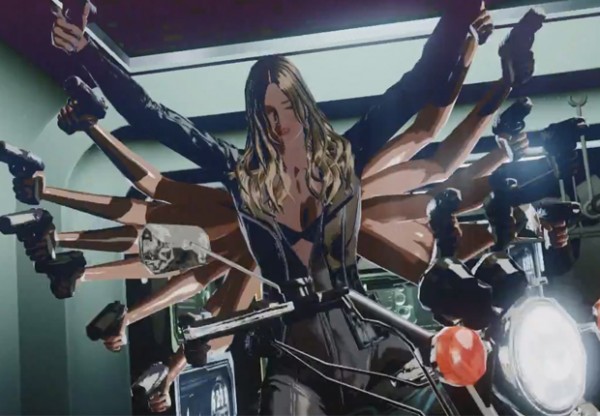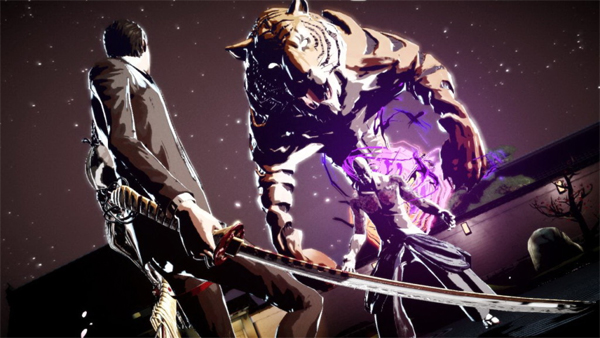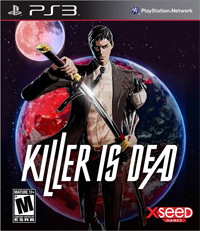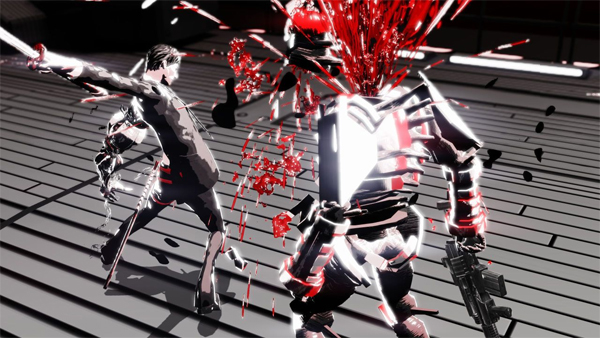Since Killer7, no game has captured that quintessential Suda51 magic as much as Killer is Dead. While games like No More Heroes and Shadows of the Damned have struck gamers with their distinct visual and mechanical stylings, only in Goichi Suda’s most recent work do gamers once again get a taste of this gaming auteur’s exquisite madness.
Killer is Dead is not devoid of the now-familiar failings of much of the Suda catalog. Two “gigolo” side missions, in which players ogle and bribe sexy femme fatales to get them into bed, are distracting, unnecessary, and out of place in the overall context of the game, and its narrative ultimately lacks a strong sense of focus as a consequence of its design. Apart from this, however, the game shines.

Jumping from mission to mission via a hub-world interface leaves the pre- and post-mission cutscenes to do a lot of heavy lifting for the game’s plot. The tale of Mondo Zappa, the cybernetically enhanced lead executioner for a team dedicated to the assassination of dangerous criminals, is already abstract and bizarre, so the freedom to select from an abundance of side missions that are only loosely tied to the story can be disruptive to one’s comprehension of the narrative. Playing straight through the story helps straighten the convolutions, but because side missions are enjoyable, diverse, and beneficial to character-building, the rewards systems in place are at odds with one another. I want to upgrade Mondo’s sword techniques, arm-cannon enhancements, and special abilities, yet I also want the crazy Suda51 story to be as cohesive as possible. Do I detour into side missions to reap the benefits within, or do I focus on incrementing the narrative — which beckons to me with every new scene — in order to keep it swirling freshly in my mind?
Perhaps that is an unfair question to ask. Killer7 was great, in part, because it didn’t spoon-feed the player. It was a challenge in a non-traditional sense: it challenged its audience to figure things out and to look beyond face value. Killer is Dead is a more accessible game that provides a variety of differing play options outside of its core structure — each side mission presents a fundamentally different perspective on the objectives of play — but indulging in its diversity doesn’t negate the game’s invitation to the player to actively engage with its foundational content.
A second playthrough was still a part of the essential Killer7 experience, and Killer is Dead once again provides players incentive for a second run that is not a chore, but an ambition. Players will want to take their initial consumption of this unconventional piece of art, and re-process the information while tracing the threads from plot point to plot point, from character to character, from beginning to end … or from end to beginning. There is undoubtedly more here than buckets of blood, random contract killings, ceremonious executions, ghosts, androids, monsters, criminals, and flashback visions. The game was obviously crafted with care and attention, and deserves to be examined with care and attention.
Venturing from the Earth, to the moon, and back again, in both the material and dream worlds, Killer is Dead stimulates with its artistic vision. The story is complemented by a striking, high-contrast art style that incorporates elements of noir and anime that are ideal for its combination of moody ambiance and high-energy action. Composer Akira Yamaoka delivers yet another fine score, besting offerings from the majority of games I’ve played this year. The music in Killer is Dead is dynamic and finely tuned, and is crucial to each new area’s significance, permeating the environment and connecting the player to a particular place, time, and mental state. Mondo is literally transported to the ends of the Earth, and even to an entirely different celestial body, and the art, in all ways, conveys those dramatic transitions.

Other artistic works from Suda51 have failed in their realization as examples of his chosen artistic medium: they failed purely as games to be played. Killer is Dead, without its art, audio, oddity, and eccentricity, would remain an excellent melee-action video game. Combat is highly satisfying, giving players the option to develop katana techniques, employ multiple different projectile weapons via Mondo’s cybernetic “Musselback” arm (and a very Big-Daddy-reminiscent drill), and choose from numerous different methods of finishing foes. A combo system rewards stringing hits without getting hit, and reaching the highest level of these ever more frenetic chains yields time-freezing kill shots that spill rewards of health, blood (which fuels Musselback), and upgrade points. Other techniques include slicing enemies cleanly in two, and using dodge-and-counter tactics to deliver furious barrages of sword slashes from just about any range. Combat is never dull, and feels like a combination of some of the key aspects of systems from Assassin’s Creed, Batman, and Ninja Gaiden games. From a mechanical standpoint, this is perhaps Suda51’s strongest offering to date.
Suda51 is almost “back.” If adolescent distractions like gigolo missions and dick jokes are what dilute the deranged creative vision presented at Suda’s inauguration into the western gaming world, then Killer is Dead proves that this auteur still has the capacity to deliver deep and arresting play experiences. The game is an impressive and well-rounded package, and may very well be worth playing twice.



















